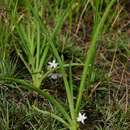en
names in breadcrumbs


Chlorophytum (/ˌklɒrəˈfaɪtəm, ˌklɔː-, -roʊ-/,[3][4] common name spider plant), is a genus of almost 200 species of evergreen perennial flowering plants in the century plant subfamily within the asparagus family.[5] The plants are native to the tropical and subtropical regions of Africa, Australia, and Asia.[2][6][7][8]
They grow to 10–60 cm tall, with a rosette of long, slender leaves 15–75 cm long and 0.5–2 cm broad and thick, fleshy tuberous roots. The flowers are small, usually white, produced on sparse panicles up to 120 cm long; in some species the plants also reproduce vegetatively by means of plantlets, tiny plants that take root on touching the ground.[3]
Chlorophytum comosum, the common Spider Plant, a native of South Africa, is a very popular houseplant especially in its variegated form 'Vittatum'. It is commonly grown in hanging pots suspended by ropes or wires in bright sunlight.[3]
Chlorophytum borivilianum is a native of India and it is used and grown as a medicinal plant.
The World Checklist of Selected Plant Families recognized 191 species as of January 2013:[2]
Chlorophytum (/ˌklɒrəˈfaɪtəm, ˌklɔː-, -roʊ-/, common name spider plant), is a genus of almost 200 species of evergreen perennial flowering plants in the century plant subfamily within the asparagus family. The plants are native to the tropical and subtropical regions of Africa, Australia, and Asia.
They grow to 10–60 cm tall, with a rosette of long, slender leaves 15–75 cm long and 0.5–2 cm broad and thick, fleshy tuberous roots. The flowers are small, usually white, produced on sparse panicles up to 120 cm long; in some species the plants also reproduce vegetatively by means of plantlets, tiny plants that take root on touching the ground.
Chlorophytum comosum, the common Spider Plant, a native of South Africa, is a very popular houseplant especially in its variegated form 'Vittatum'. It is commonly grown in hanging pots suspended by ropes or wires in bright sunlight.
Chlorophytum borivilianum is a native of India and it is used and grown as a medicinal plant.

Flower of C. comosum

Fleshy tuberous roots of C. comosum